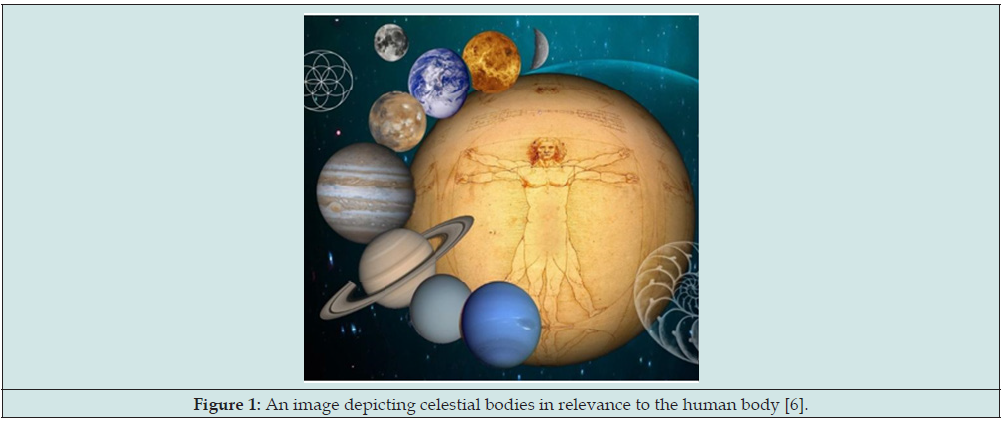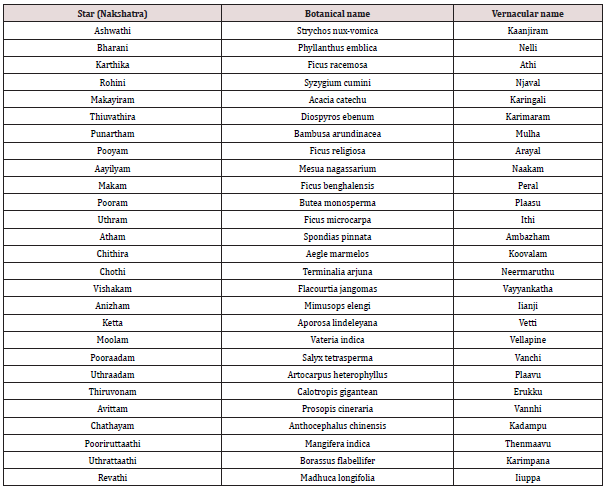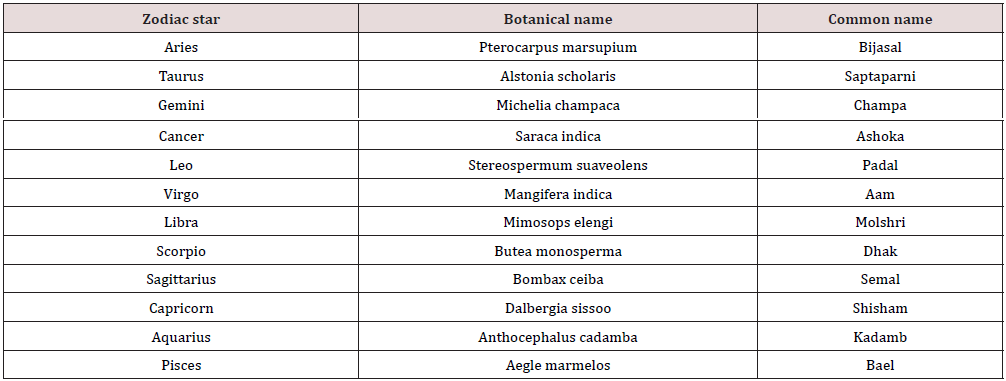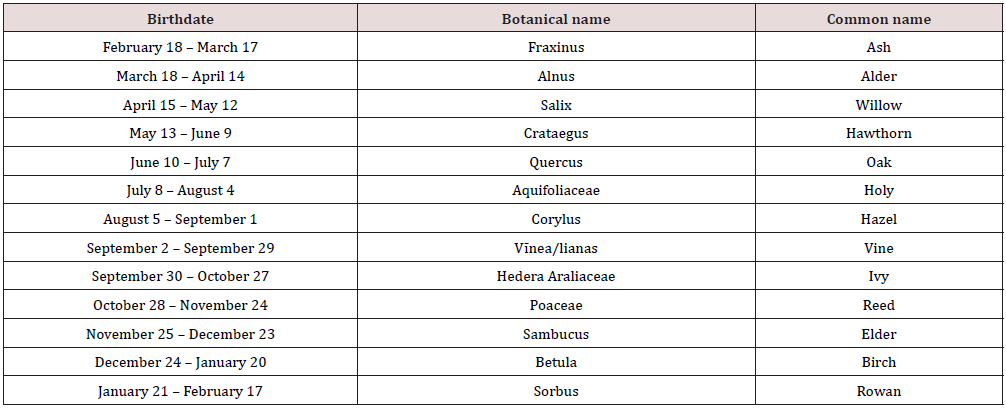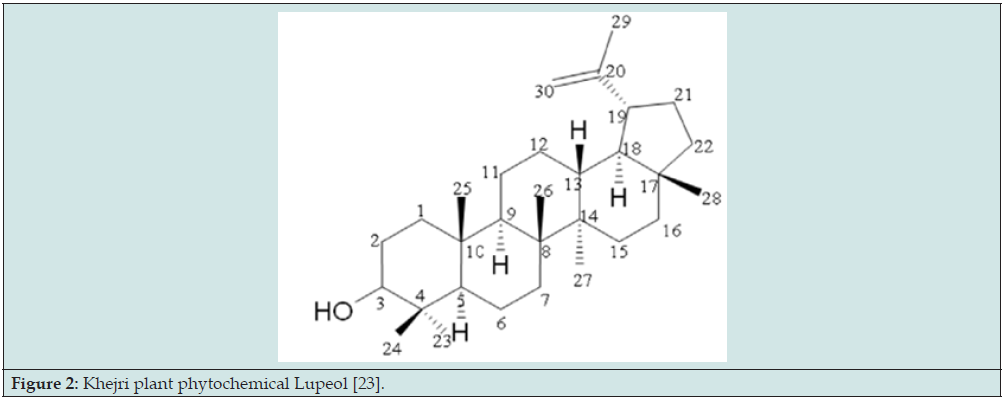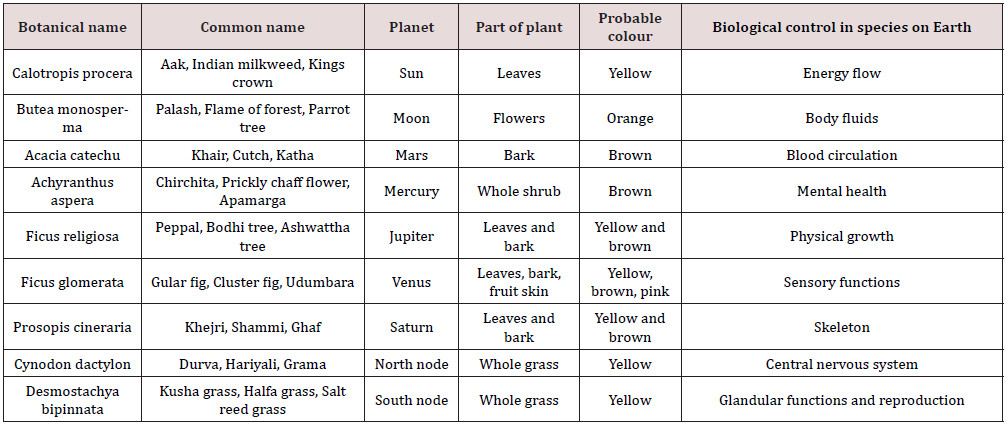
Lupine Publishers Group
Lupine Publishers
Menu
ISSN: 2637-4595
Review Article(ISSN: 2637-4595) 
Cosmic Designs and Colours on Fabrics Combined with their Believable Effects on the Human Psyche Volume 5 - Issue 3
Alka Madhukar Thakker* and Danmei Sun
- School of Textiles and Design, Heriot Watt University, UK
Received:December 19, 2022 Published: January 12, 2023
*Corresponding author: Alka Madhukar Thakker, Email : roseswaterlilies@gmail.com
DOI: 10.32474/LTTFD.2023.05.000212
Abstract
Astrology (In the context of Indian culture) is a science that provides a blueprint indicating our subtle and strong relationship with the twelve planets in the universe. As detailed here, these twelve planets correspond to twelve celestial designs and plants. Furthermore, these twelve designs and extracts from the plants could be applied to the textile substrates preferentially ecologically implementing circular materials. The study hypothesized that wearing those fabrics as per our birth planets could influence our psyche accordingly. The probable influence is also elaborated in this paper. The innovative connection highlighted in the study is a unique contribution to textile design. Moreover, the traditional celestial designs and novel natural dyes from the plants could be applied to the fabrics without psyche connections. A practical application of the research theory and validation with quantitative and qualitative analysis is recommended for future research and development.
Keywords: Textile Design; Natural Dyes; Astrology; Cosmic Design; The Human Psyche; Circular Materials; Biomimicry
Abbreviations: NASA: National Aeronautics and Space Administration
Introduction
Sustainability is at the fore, so the textile industry is ambitiously parading towards alternative ecological materials to refute the air and water pollution from petroleum-based contenders. Biomimicry, inspiration from nature, would assist in solving problems to meet the “needs” sustainably; it impels plant-based renewable sources to circumvent depleting fossil fuels creatively and harmoniously [1]. In the words of Sir A. Einstein, “Look deep into nature, and you will understand everything better”. A lot is derived from the ancient traditional knowledge of healing from plant-based natural resources and replanting them to protect biodiversity, accentuating the saying “From nature back to nature” [2]. Moreover, scientific research investigations accomplished on natural colours from plants indicate there is no possible health treatment or toxicity to humans and animals alike [3]. They are predominantly synthesized from natural fruits, flowers, stems, leaves, barks, grasses, seeds, roots, trees, and berries. The molecules of natural origin are biodegradable, whereas synthetic chemicals lack biodegradability, and they remain in the environment releasing toxic fumes [4]. Cosmic designs and colours on fabrics combined with their believable effects on the human psyche serve as an example of Biomimicry. The influences are vibrational, subtle, and relative.
A primary understanding of the planets and their influence on human systems has been made. Also, their corresponding plants and symbols are believed to play a vital role in strengthening the human systems or simply being fortunate for the wearer. There is research on corresponding animals, colours, metals, geographic regions, and others that are unique, auspicious, and important to each person. This paper aims to investigate the planets, plants, and symbols for application on natural fabrics.
Science of Associated Plant-Planet for Cosmic Healing.
Astrobiology
As per the National Aeronautics and Space Administration (NASA), Astrobiology (Astrology + Biology) is the branch of biology concerned with the study of life on earth. It is the study of the origin, evolution, distribution, and future of life in the universe. The influence of the planets on the human body is recognized as an example of astrobiology’s ability to make a higher connection between humans and the “divine aka universe” as depicted in (Figure 1) [5] Typically, the celestial bodies which are the Sun, Moon, Mercury, Venus, Mars, Jupiter, Saturn, Uranus, Neptune, and Pluto are thought to influence humans as summarised in (Table 1) [6]. Understanding how the body interacts with the planets can offer a vital understanding of the connection human beings have with our universe. Going deeper into this knowledge by learning the symbolic connections between the planets and our bodies can potentially galvanize our understanding of our connection to the “divine”. The ancient shamans, sages and metaphysicians understood the symbolic planetary meanings in connection with the body. Our ability to understand and apply the “rules” of the Divine Matrix holds the key to our deepest healing, our greatest joy, and our survival as a species [7].
Geomagnetism
“All biological systems on Earth are exposed to an external and internal environment of fluctuating invisible magnetic fields with a wide range of frequencies. These fields can affect virtually every cell and circuit to a greater or lesser degree” [8]. It has been found that the human autonomic nervous system responds to environmental influences, particularly changes in solar and geomagnetic activity, cosmic rays and the frequencies known as the Schumann resonances. One study suggested that the parasympathetic nervous system activity is enhanced during periods of increased solar radio flux and cosmic rays. “Human regulatory systems are designed to adapt to daily in addition to seasonal climatic and geomagnetic variations; however, sharp changes in solar and geomagnetic activity and geomagnetic storms can stress these regulatory systems, resulting in alterations in melatonin/serotonin balance, blood pressure, immune system, reproductive, cardiac, and neurological processes” [8]. These changes can positively and negatively affect human physiology and psychology. India has a rich heritage of Jyotish Shastra, the fusion of astrology and astronomy. However, in general, astrology is considered pseudoscience since it is inconceivable for modern science that distant astronomical bodies can influence human beings. Nevertheless, studies have demonstrated that the movement of the moon across the 27/28 asterisms has harmony with the duration of four human normal biological developmental stages when evaluated in terms of sidereal-lunar time with lunistellar months as the unit [9]. The human menstrual cycle interval, gestation period, childhood and adulthood are 1, 10, 100 and 1000 lunistellar months, respectively, the relation being loglinear (101, 101, 102 and 103). Such harmony between biological phenomena and stellar time is not seen in any other living being. These phenomena are celebrated by Hindus in various ways. These periods are also explainable as being the four kinds of time (Pitrya, Brahma, Divya and Prajapatya) related to creation and destruction described in Surya Siddhant [10]. These observations suggest that the human body has a strange and unique harmony with nature. The body is a microcosm of the gigantic external cosmos. The ancient Indian practitioners of Jyotisha were aware of this and initiated various rituals to mark them. The events had a predictive value depicted in the form of a birth chart. Therefore, astrology may not be a pseudoscience, but in fact can offer a clear, genuine link between environmental conditions, nature, and human health.
Since its commissioning in the late 1990s, the International Space Station of NASA has enabled research that provided a better understanding of many aspects of human health including ageing, trauma, disease, and environmental impacts. Driven by the need to support astronaut health, several biological and human physiological investigations have yielded important results that we on Earth can also benefit from. These results include new ways to mitigate bone loss, insights into bacterial behaviour, and innovative wound-healing techniques. Advances in telemedicine, disease models, psychological stress response systems, and nutrition and cell behaviour are just a few more examples of the benefits that have been gained from applying studies in orbit to human health back on Earth (National Aeronautics and Space Administration n.d.).
The star at birth and the corresponding tree
The manifested universe is composed of five elements, i.e., space, air, fire, water, and earth. The ancient texts document that the nearest celestial bodies are the planets, and their satellites affect us (86). The nearest to Earth are the Moon, Sun, Mars, Venus, Mercury, Jupiter, Saturn and the two lunar nodes, the North lunar node, and the South lunar node [10]
a. Moon star and the associated plants
The Moon is the closest planet to the Earth and has a profound influence on the Earth. The moon’s presence in the sky has long pervaded human culture influencing themes for music, song, poems, and language. In the celestial planetary world, the moon is orbiting the earth at a speed of 1.022 km/s. When it is closest to the Earth it is at a position known as the “perigee” and when it is at its furthest the position is known as the “apogee”. Although the moon is far less massive than the sun, this is more than compensated for by its relative closeness to the Earth. Thus, the forces exerted by the moon are two to three-folds stronger than the sun and it is strongest at the perigee. This increased magnitude explains the moon’s greater influence on life on the Earth, human behaviour, tidal forces, day lengths, super moon, blue moon, and eclipse and follows the lunar calendar. The tidal forces exerted by the moon on the ocean waves are just over twice as strong as the solar tide. Tidal forces are experienced by the human body as well and because of the similar length of the lunar month and the human menstrual cycle, the moon has an influence on human fertility and may even affect mental health [11]. The moon also affects the behaviour of wildlife in numerous ways, for example, nocturnal animals tend to vary their activity with the phase of the moon, according to whether the extra light around the full moon is helpful or harmful to their success as predators or safety as prey. Many marine species also use the moon as a clock to trigger mass spawning, not because of the light levels, but because the success of their reproductive strategy depends on synchronization. Some turtles wait for spring tides so they can come ashore easily and lay their eggs in areas that will stay dry until their young hatch [11].
The moon’s presence stabilizes the tilt of the Earth’s axis, and this tilt is responsible for the seasons as the earth progresses around its orbit. Currently, the tilt angle is 23.4° but it does change slowly with time. Calculations suggest that over the past five million years the tilt has varied by about 2.5° which has affected the climate, as has been evidenced in the fossil record (67). Studies in the 1900s suggested that if the earth had no moon, our axial tilt would experience much wilder fluctuations, ranging from 0 to nearly 90°. This would have led to major extremes in the climate, even worse than those experienced by Mars, which has only tiny moons and where its axial tilt is currently varying between about 5 to 45° [11]. The subtle vibrations of seasonal sunlight and moonlight are reported to influence animal and plant physiology. These changing connections to the astral bodies are better understood through astrology and can better predict Nature, climate, and animal/plant interactions. With a deeper understanding of Astro-science, we can better predict our life concepts of health and medical astrology [10,12]. Bridging astronomy, botany, and healing our body requires healing at three levels. The first level of healing is the physical aspect where we can view and feel the benefits. The second one is the astral-subtle body, where the mind and intellect reside and lastly there is the causal body, our doorway to higher consciousness. The necessary healing energy is received from the higher species such as plants and trees where plants on some levels can be regarded as more advanced than animals.
If we consider the relative genomes, it is apparent that there are between 20,000 to 25,000 genes in the human DNA, whereas for “simple” rice there are between 46,000 to 55,000 genes in the DNA. Simply, the larger the gene size, the higher the entity has evolved.
The ancient texts are rich with references to Siddhas or Yogis who meditated under a tree and reached nirvana or an enlightened state [10,13]. Indeed, Sage Durvasa and Adi Shankaracharya, meditated under The Kalpavriksha and Buddha meditated under the Bodhi Tree. The enlightened souls, the rishis and sages were able to identify various locations, symbols, gemstones, and trees that would heal all the three layers of the human body for a person born at a particular time. They identified nine trees for the nine planets that would cover 30 degrees of the zodiac called the Rashi trees. They also identified 27 stars that are reported to affect humans and their trees called nakshatra trees, as shown in (Table 2) [10]. The sages further divided each star into four components called the padas and found their corresponding trees. Therefore, in total, there were 108 components involved in the astral influence. In the same vein, the description of Sun stars aka Zodiac signs with their corresponding plants are organized in (Table 3). The Celtic system of birth stars and the relative healing plants are shown in (Table 4).
b. Sun star and the related plants
The Sun signs with associated healing plants are shown in (Table 3).
c. Celtic Moon chart with accompanying plants
The philosopher Poisonous described the Celts as ‘noble savages’ (Cunliffe n.d.). However, they also had a sophisticated culture with strong religious beliefs known as Druid priests they were also fierce warriors. The Druids were experts in the properties of plants and keenly aware of the seasons and stars (Table 4) shows the typical Celtic-based astrological signs and their associations with medicinal trees [6]. Thus, there are varied astral charts as shown above. Based on astrobiology we selected to investigate the corresponding relationship between the nine planets and the nine ruling planets.
Nine planets at birth and the associated plants
In the same vein, (Table 5) demonstrates nine planets at birth and the nine plants associated with them. These plants are believed to be auspicious for the person as per his/her birth star. Scared grooves promulgate the plantation and consumption of the plants as per birth planet to overcome obstacles and attract fortune.
Planet-plant healing concept
The nine plants corresponding to the nine planets are described here with their healing benefits to humans [14]. In this, we discuss the diseases caused in human beings due to the weak planetary position as per astrophysics. Interestingly it is realized that these nine plants, one for each planet, provide the cure, both on consumption, direct application and wearing. This assists to heal the diseases caused due to the weak planet.
Planet-Sun-The Father
Associated plant-Calotropis procera.
Diseases caused due to a weak planet-Weak eyesight, weak bones, headaches, overheating, heart and dental trouble, weak immune system, blood pressure, fever, mental illness, baldness, and neuralgia.
Medicinal cures with Calotropis procera-Skin diseasessmallpox, scabies, ringworms, leprosy, chronic eczema, athlete’s foot, night blindness, rheumatism, scorpion bites, asthma, cataracts, inflammations, fevers, and tumours. Anti-fungal, anti-cancerous, anti-oxidative, anti-coagulant and anti-inflammatory agent.
Planet-Moon-The Mother
Associated plant-Butea monosperma.
Diseases caused due to a weak planet-Anemia, blood pressure, fever, water retention, female disorders, neurological disorders, and weakness.
Medicinal cures with Butea monosperma-Anaemia, diabetes, antimicrobial, anti-inflammatory, analgesic, astringent, and antimalarial.
Planet-Mars-The Commander-In-Chief
Associated plant-Acacia catechu.
Diseases caused due to a weak planet-Skin rashes, overheating, ulcers, inflammations, mental aberration, fevers, and epilepsy.
Medicinal cures with Acacia Catechu-Skin psoriasis, skin disorders, body pains, sores, blood clotting, anemia, leprosy, ulcers, boils, anti-bacterial and antifungal, astringent, diabetes, and antiinflammatory.
Planet-Mercury
Associated plant-Achyranthes aspera.
Diseases caused due to a weak planet-Asthma, respiratory and psychic disease, insomnia, skin diseases, vertigo, deafness, and nervous breakdown.
Medicinal cures Achyranthes aspera-Skin disorders, eczema, leprosy, boils, oedema, insect bites, eye and ear diseases, scabies, syphilis, aches and pains, astringent, asthma, ulcers, and warts.
Planet-Jupiter
Associated plant-Ficus religiosa.
Diseases caused due to the weak planet-Asthma, jaundice, liver, pancreas and ear problems, diabetes, anemia, tumours, and absorption and circulation congestion.
Medicinal cures with Ficus religiosa-Antibacterial, antioxidant, wound-healing, hypoglycemic, asthma, ulcers, leucorrhea, constipation, skin disease, scabies, heal wounds, gout, gum disease, cooling, and blood ailments.
Planet-Venus
Associated plant-Ficus glomerata.
Diseases caused due to a weak planet-Anemia, cataracts, asthma, cold, cough, and diabetes.
Medicinal cures with Ficus glomerata-Antibacterial, antiinflammatory, analgesic, radioprotective, antioxidant, diabetes, leprosy, asthma, anemia, boils, oedema, to improve skin complexion, astringent, blood disorders, burning sensation, fatigue, scabies, to clean wounds and ulcers, chronic wounds, pain and promote healing, and mumps [14].
Planet-Saturn
Associated plant-Prosopis cineraria.
Diseases caused due to a weak planet-Asthma, skin diseases, pains, blindness, rugged hair, and ear problems.
Medicinal cures with Prosopis Cineraria-Astringent, leprosy, asthma, rheumatism, eye troubles, stings, anti-inflammatory.
Planet-Rahu
Associated plant-Cynodon dactylon.
Diseases caused due to a weak planet-Cataract, blisters, boils, skin ulcers, and high blood pressure
Medicinal cures for Cynodon dactylon-Hypertension, headache, asthma, cough, cramps, snakebite, warts, wounds, eye disorders, dandruff, sores, astringent for cuts and wounds.
Planet-Ketu
Associated plant-Desmostachya bipinnata.
Diseases caused due to a weak planet-Fever, eye and ear disorders, mysterious diseases, wounds, inflammation, and blood pressure.
Medicinal cures with Desmostachya bipinnata-Positive radiations thus utilized for meditation mats and to prevent contamination from harmful radiations, anti-bacterial, skin diseases, excessive perspiration, and burning sensation, improves complexion, heals wounds internally and externally, epilepsy, diabetes, and anti-bacterial [14].
Planet-plant application on fabrics
Calotropis procera aka Akdo and Milkweed, its leaves were observed to be an eco-friendly source of natural colorants for textile. It was investigated that a high level of dye was obtained upon microwave irradiation of alkali-solubilized extract for 4 min. The application of NaCl at a concentration of 3 g/100 ml at 55 °C improved the colour strength of dyed cotton fabrics significantly. Among the studied bio-mordants, 5%. Nilotica bark extract significantly improved the colour strength as a pre-mordant. However, the highest colour strength was obtained with 9% Curcuma longa tuber extract as post-mordant [15]. Butea monosperma aka Palash, a study was done on natural dyes from flowers, leaves, and barks of Butea monosperma and analysed for its application on cotton fabric with natural mordants. Almond shells, walnut shells, harda fruits and bahera fruits were used as natural mordants. The dye powder and mordants were extracted in distilled water. The fabric was pre-mordanted and then dyed. A large range of colour shades was obtained, because of varying mordant concentrations. The best dyed samples were selected based on maximum colour strength and were evaluated for their colour fastness properties viz. washing, rubbing, light, and perspiration, showing fair to excellent fastness numerical ratings. The results showed the leaf is a good source of dyes [16]. Similarly, the Cotton Khadi fabric was colored with natural dye extracted from the petals of the Butea monosperma flower using different natural mordants like P. Granatum, P. Emblika T. Bellirica, and A. Catechu. Cotton Khadi fabric samples dyed with Butea monosperma with 30% concentration of dye and 15% mordants concentration using the pre-mordanting method gave excellent wash and rub fastness ratings with all mordants. P. Granatum and T. Billerica mordants with the pre mordanting method using different mordant concentrations i.e., 5%, 10% and 15% as compared to all other mordants produced moderate fading to no fading against blue-dyed standards of a 1-8 rating scale.
The dyed samples showed very good colour strength (K/S) and colourimetric appearance using CIE l* a* b* colour space in terms of colour coordinates. The fabric samples mordanted with P. Granatum gave very good colour strength with all concentrations of dye and mordants as compared to other mordants. Large ranges of shades were obtained using different types of mordants and their concentrations with petals of Butea monosperma dye [16]. Acacia catechu aka Katha plant extract was applied to the cotton fabric to provide an antibacterial finish. Cotton fabric was treated with natural mordants pomegranate and myrobalan and dyed with acacia catechu. The fabrics were finished with three herbal methanolic extracts of tridax procumbens (Jayanti), Plectranthus amboinicus (Indian mint), Spanish thyme, and Mentha piperita (peppermint) by using the dip method and pad dry cure method (M 2018). The antibacterial finishes of the finished fabrics were assessed against gram-positive and gram-negative bacteria and concluded that the pomegranate mordanted fabric finished with Tridax procumbent herb using pad dry cure method gives the excellent result. The 8% of citric acid was used as a cross-linking agent. It could help to protect by keeping human beings free from skin infections, fungal growth, and bad odour. The in-vitro antibacterial activity of ethanolic bark extract of Acacia catechu wild against enteric pathogens was analysed [17]. The inhibitory effect was tested against five gram-negative bacilli and one gram-positive coccus by using the disc diffusion method. (Mic) minimum inhibitory concentration and (mbc) minimum bactericidal concentration values were determined. It was found that the ethanolic bark extract exhibited antibacterial activity against Staphylococcus aureus and Shigella dysentriae with a minimum inhibitory concentration of 1 mg/ml and minimum bactericidal concentrations of 1 mg/ml, proving it to be efficient bactericidal [17]. Dyeing with Katha is utilized mainly to dye cotton as it is very high in tannin and can be used as a mordant instead of tannic acid. It can also dye silk and wool. It contains two dyes, catechu-tannic acid, which is soluble in cold water, and catechin, which needs hot water to dissolve [18].
Achyranthus aspera aka Chirchita and prickly chaff leaves were innovatively utilized as a source of eco-friendly and renewable anti-microbial finish on the fabric for application as healthcare textiles. The chemical nature of the leaf extract was determined using HPLC and extraction of the active substance from the leaves was done using methanol. The method of application of this herbal extract on cotton fabric using citric acid as a cross-linking agent and the process variables have been standardized using a Box and Behnken three level-three variable experimental design [19]. The antimicrobial activity of the finished fabric based on optimised process parameters was assessed against bacteria that normally exist in the textile environment like gram-positive, Staphylococcus aureus (AATCC 6538) and gram-negative, Escherichia coli (AATCC 11230) by both quantitative method (AATCC 100) and qualitative methods like parallel streak (AATCC 147) and agar diffusion method (SN 195 920). The finished cotton fabrics showed a bacterial reduction percentage of 92 and 50 against S. aureus and E. coli, respectively. The active substance responsible for antimicrobial activity was found to be betaine [17]. Ficus religiosa aka Pippdo is the eco-friendly natural dye obtained from the bark of Ficus religiosa for application on cotton fabric. The dark red dye colour was extracted in distilled water. The cotton fabric was dyed and simultaneously mordanted with natural mordants like alum, myrobalan and cow dung (Saravanan, Chandramohan and Saivara, a Study on Eco-Friendly Natural Dye Obtained from Barks of Ficus religiosa. L on Cotton Fabric 2012). Dye extract was tested with inductively coupled plasma mass spectrometry for the presence of heavy metals. It was proved that antimony, arsenic, cadmium, and lead were not present in the dye bath and were deemed safe for human and environmental health. The wash, light and rub fastness properties obtained were good, in the range of 4-5, 4 and 4-5 respectively. Additionally, colours could be extracted from 4 out of 20 species of Ficus plant bark. Mercerized cotton fabric was dyed with alum mordant. Almost all parts of a plant such as bark, leaf, seed, fruit, stem, and roots yield a wide range of colours. Light pink to red colour shade ranges were obtained from barks [20]. In the same vein, the effect of biotreatment with chitosan and mordants on dyeability of cotton fabrics with natural dye from barks of Ficus religiosa was apprehended. Chitosan, a biopolymer obtained from the deacetylation of chitin was utilized. It has the film-forming ability, chelation, adsorption, and antimicrobial activity. The colour strength and K/S values of chitosan treated fabrics were higher than the untreated fabrics. The K/S value increased with an increase in the concentration of chitosan. Chitosan made the fabric stiffer and a bit yellower than the untreated fabrics (Saravanan, Chandramohan and Rani, et al. 2013). Post mordanting method showed a higher depth of shade than pre and simultaneous mordanting. A remarkable increase in the wash and light fastness properties was observed in the fabric treated with chitosan. Ficus glomerata aka Gular, the phytochemical screening of leaf galls aqueous extract of Ficus glomerata revealed the presence of carbohydrates, saponins, alkaloids, flavonoids, and phenolics. These bioactive compounds impart natural antioxidant properties for applications in varied medicinal end-use [21]. Antibacterial activity of various extracts of the fruits of Ficus glomerata was tested on gram-positive and gram-negative bacteria using zone inhibition. The bacteria used in the test were Bacillus subtilis, Pseudomonas aeruginosa, Escherichia coli, and Staphylococcus aureus. The benzene, chloroform, and aqueous extracts of fruits of Ficus glomerata exhibited significant antibacterial activity against all the micro-organisms at higher concentrations (500 μg/ml and 1000 μg/ml. Preliminary phytochemical screening of the fruit extract by the Soxhlet apparatus in different solvents showed the presence of alkaloids, tannins, saponin, flavonoids, steroids, and glycosides [22].
Prosopis cineraria aka Khejri, the phytochemical analysis of the chloroform extract of stem bark of Prosopis cineraria, revealed five compounds that were isolated, 1-methyl 5-tridecyloctadec-4-enoate, 2-nanocosan-8-one, 3-lupeol, 4-b-sitosterol and 5-stigmasterol. The structure of these compounds was identified using spectral data analysis as an example of the Lupeol phytochemical composition is displayed in Figure 2 [23]. The antibacterial and antioxidant activities of leaf extracts of Prosopis cineraria were evaluated. Total phenolic content in the leaf was found to be 548 and 654 mg/g extract, while the total flavonoid content in the leaf was found to be 184 mg/100g to 231 mg/g extract, respectively. For antibacterial activity, aqueous and methanol extracts were tested for their antibacterial activity against Staphylococcus aureus, Streptococcus pneumonia, Bacillus cereus, Escherichia coli, Pseudomonas aeruginosa, salmonella typhi, Proteus vulgaris, Shigella flexneri, and Klebsiella pneumonia. Of the two extracts, methanol extract showed significant activity against S. aureus followed by S. pneumonia and E. coli. The aqueous extract exhibited no activity [24]. Cynodon dactylon aka Durva is a perennial grass distributed all over the world, and particularly it is native to warm temperate and tropical regions. The plant is rich in metabolites, notably proteins, carbohydrates, minerals, flavonoids, carotenoids, alkaloids, glycosides, and triterpenoids. The whole grass performs antibacterial, antimicrobial, antiviral, and wound healing properties [25]. The detailed phytochemical constituent analysis of Durva by GC-MS Gas Chromatography Mass Spectrometer analysis revealed the presence of 24 secondary bioactive compounds as given in (Table 5). Desmostachya bipinnata, the phytochemical profile and antibacterial activity of Desmostachya bipinnata have been reported.
Table 6: Phytochemicals in Durva and their medicinal significance (Venkatachalam, et al. 2018) (Kaliyaperumal, Kumarakurubaran and Muthu Krishnan 2013).

The sample of essential oil was obtained from the aerial parts of the plant by hydro-distillation and analyzed by GC/MS (49). From the 16 compounds representing 99.97% of the oils: camphene (16.79%), isobornyl acetate (9.92%), tricyclene (4.30%), (+, -) trans-2, 6-gamma-iron (2.21%), caryophyllene diepoxide (12.29%), β-eudesmol (11.16%) eseroline (25.15%) and calarene (3.48%) appear as the main components. The oil also contained smaller percentages of diphenyl iodonium bromide, 1-. limenone, 2-cyclohexene-1-one and 8-nitro-12-tridecanolide. Furthermore, an antibacterial study of the oil was evaluated using agar diffusion and broth dilution methods. The antibacterial studies showed that the oil had a significant inhibitory effect on all four bacteria strains included in the study [26]. The present investigation deals with the phytochemical evaluation and in-vitro antioxidant activity of root-stock powder extracts of Desmostachya bipinnata. The phytochemical evaluation of the hexane, chloroform and methanol extracts revealed the presence of sugar, protein, flavonoids, tannins, steroids, terpenoids and fatty acids. The n-hexane extract was analyzed by GC/MS technique and found to contain 10 compounds. The major components were Juniper Camphor, Lilac Aldehyde, Vernucarol, and N-Hexadecanoic Acid. HPTLC fingerprinting profile of the extracts was developed, which would serve as a reference standard. In-vitro antioxidant activity of methanolic extract of rootstocks of Desmostachya bipinnata was determined by DPPH, nitric oxide radical scavenging and reducing power methods. The ic50 values for DPPH and nitric oxide radical scavenging assay were found to be 4.25μg/ml and 106.38μg/ml, respectively, and showed a significant free radical scavenging activity. The maximum reducing power of the extract of 100 g/ml was found to be 0.94350.081, which is measured at 700 nm [27]. The present phytochemical (GC/MS) evaluation indicates that the rootstock extracts of Desmostachya bipinnata are rich in many phytoconstituents which contribute to the activities reported earlier and the methanolic extract has significant in-vitro antioxidant activity. Table 6 demonstrates phytochemicals inherent to every nine plants that were selected in the study. Table 7 indicates the diameter of the zone of inhibition of bacterial growth of each of the nine plants. The data in Tables 6 & 7 is responsible for functional properties.
Results and Discussion
As distilled from the above sections the nine designs as shown in Figure 3 were selected for printing on textile fabrics. Since ancient times these designs have been constructed as Rangolis on the earth’s surface for decorative purposes during the festivals. They are auspicious figures and are revered. Afterwards, they are mandatorily carefully and delicately collected and organically decomposed. These designs cannot be mistreated, otherwise, they could be ill-fated for the individual and surroundings. They are popular in India as Muggulu designs. There are several Muggulu designs of which the selected nine designs correspond to nine planets in space as shown in Figure 3. Muggulu art is a dot-matrix design traditionally made on a clean floor with rice flour. These designs in specific are most revered and auspicious. In India, they are known as Navagraha Rangoli Designs and Weekdays Rangoli Patterns or Navagraha Kolam (drikpanchang.com n.d.) (Kumari 2018).
Figure 3: Traditional planetary designs for application on fabrics (drikpanchang.com n.d.): (1) Moon/Monday/Chandra planet design, (2) Mars/Tuesday/Mangal planet design, (3) Mercury/Wednesday/Budha planet design, (4) Jupiter/Guru/Thursday planet design, (5) Venus/Friday/Sukra planet design, (6) Saturn/Shani planet design, (7) Sun/Sunday/Surya planet design, (8) North Node/Rahu planet design, and (9) South Node/Ketu planet design.
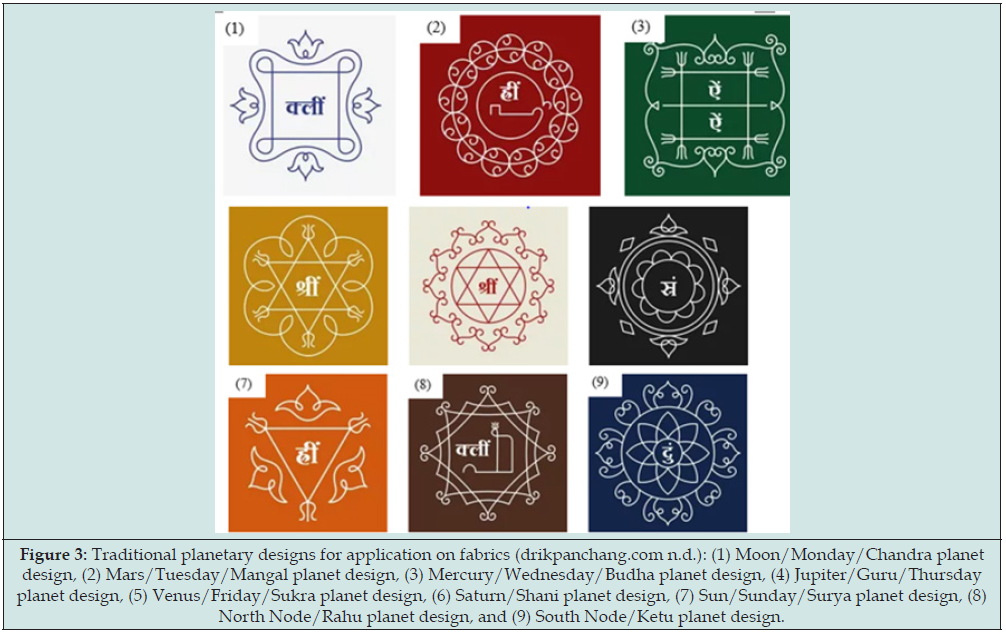
Planetary Designs
Planetary Plants: As discussed in the literature the nine plants corresponding to nine planets with functional phytochemicals were concluded for application on textile substrate (Table 8 & Figure 4). provide essential details on each plant, its influence on the human system, probable colour on natural fabric and their images.
Figure 4: Nine planetary plants were selected for the study. (1) Calotropis procera, a Sun planet plant [38], (2) Butea monosperma, a Moon planet plant, (3) Acacia catechu, a Mars planet plant [40], (4) Achyranthes aspera, a Mercury planet plant (Flore des îles Canaries n.d.), (5) Ficus religiosa is a Jupiter planet plant [34], (6) Ficus glomerata is a Venus planet plant (Pixabay n.d.), (7) Prosopis cineraria is a Saturn planet plant (eBay Inc. 1995-2022 ), (8) Cynodon dactylon, a North lunar node planet plant, and (9) Desmostachya bipinnata, a South node planet plant [30,42].
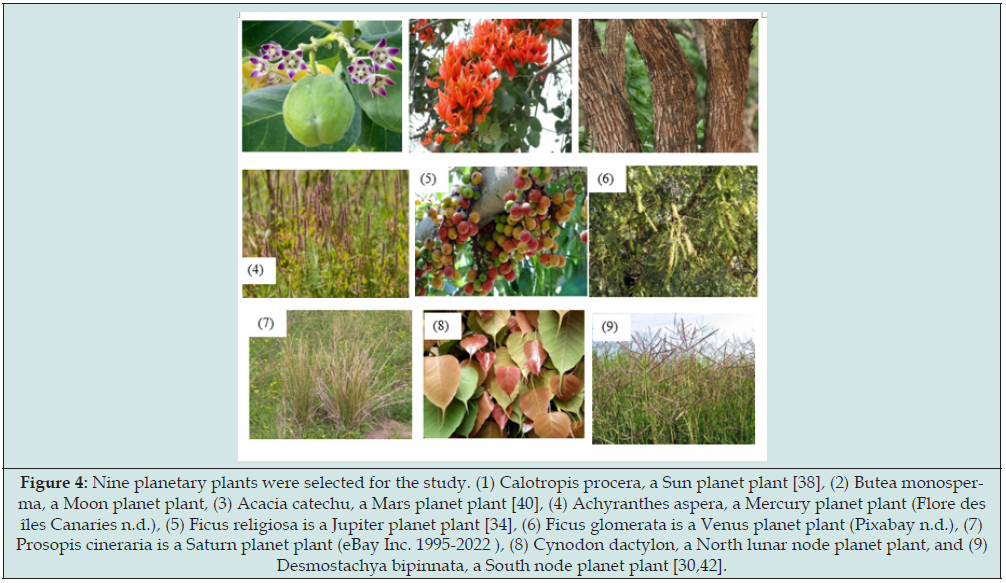
Conclusion
A divine design of the universe to provide healing energy to balance the body logarithm is concluded in this study manifested in the form of designs and colours for fabrics about the individual’s lucky planet. This mystical imagery is difficult to understand, digest and many-a-time invokes a transcendental feel. It could defy ordinary comprehension and challenge the logic of the enquiring mind. The study also serves as an example of biomimicry. Nine designs corresponding to nine planets are traditional designs of reverence in Indian culture. The nine plants associated with each planet are dense in functional phytochemicals responsible for providing the required healing.
Future work
Several modern designs and colours could be created from the traditional designs and plant-based colours put forth in the study. The symbols associated with each planet are displayed in (Figure 5). These symbols could be potentially explored and incorporated into fabrics, hence suggestions for future research and development.
Disclosure statement
The author reported no potential conflict of interest.
References
- Minney, Safia (2016) Slow Fashion: Aesthetics Meets Ethics. Oxford: New Internationalist Publications Ltd.
- Cardon, Dominique (2007) Natural Dyes-Sources, Tradition, Technology and Science. London: Archetype Publications Ltd.
- Vankar, Padma Shree, and Dhara Shukla (2019) New trends in natural dyes for textiles.
- Sharma, Deepakshi, Rajdeo Singh, and Bhushan Dighe(2018) Chromatographic study on traditional natural preservatives used for palm leaf manuscripts in India. Restaurator. International Journal for the Preservation of Library and Archival Material (De Gruyter) 39(4): 249-264.
- Williams, Matt (2019) Symbols of the Planets. Universe Today 26 07.
- Venefica, Avia (2005) Sapere Aude, Dare to Discern. Whats-Your-Sign.com.
- Braden, Gregg (2019) Bridging science, spirituality and the real world, A deep truth from Gregg. Gregg Braden.
- HeartMath Institute (2017) Effects of geomagnetic, solar, and other factors on humans-Heartmath Institute. HeartMath Institute.
- Bhattathiri, Narayanan V (2016) How planets influence human growth and development. BioAstrology: Principles of the Alternative Science of Jyothisha pp.8.
- Jayaprakash, Velu (2016) Cosmic healing with birth stars and trees. Swarna Prashana.
- Rothery, David A (2015) Moons: A Very Short Introduction. Oxford, Oxford University Press, UK.
- Vedicgrace Foundation (2017) The nine planets have their roles and their effects on the human body. Vedicgrace Foundation.
- Tambe, Balaji (2013) The untold secrets of life. Karla, India: Balaji Tambe foundation.
- Sood, Sanjay (2014) Plantation of traditional Indian plants through people’s participation in Hamirpur district, Himachal Pradesh. Himachal Pradesh, India: Forest Research Institute University.
- Hussaan, Muhammad, Naeem Iqbal, Shahid Adeel, Muhammad Azeem, Tariq M Javed, and Ali Raza (2017) Microwave-assisted enhancement of milkweed (Calotropis procera L.) leaves as an eco-friendly source of natural colourants for textile. Environmental Science and Pollution Research 24: 5089-5094.
- Tiwari, Adya, and Meenu Srivastava (2018) Cotton Khadi fabric dyeing with natural dye extracted from the petals of Butea monosperma Flower using different mordants. Asian Journal of Home Science 13 (1): 187-194.
- Thangavelu, Lakshmi, Geetha V R, and Anitha Roy (2011) In vitro antibacterial activity of ethanolic bark extract of Acacia catechu willd against enteric pathogens. International Journal of Drug Development & Research 3 (3): 328-334.
- Wild Colours and natural dyes (2006) Dyeing with Cutch (Acacia catechu) Wild Colours and natural dyes.
- Thilagavathi, G, and T Kannaian (2008) Application of Prickly Chaff (Achyranthes aspera Linn.) leaves as a herbal antimicrobial finish for cotton fabric used in healthcare textiles. Natural Product Radiance 7 (4): 330-334.
- Choudhary, Mahendra Singh, Sharad Trivedi Upadhyay, and Ravi Upadhyay (2012) Observation of Natural Dyes in Ficus Species from Hoshangabad District of Madhya Pradesh. Bulletin of Environment, Pharmacology and Life Sciences 1 (10): 34-37.
- Eshwarappa, Ravi Shankara Birur, Shanthi Iyer, Rajan Sundara Subaramaihha, Austin S Richard, and Dhananjaya Bhadrapura Lakkappa (2015) Antioxidant activities of Ficus glomerata (Moraceae) leaf gall extracts. Pharma Cognosy Research 7(1): 114-120.
- Menezes, Cylma, J V Kamath, Satyanarayana D, Anurag Mishra, Sandeep, Ashutosh Mishra (2013) Antibacterial activity of fruits of Ficus glomerata. Journal of Harmonized Research in Pharmacy 2 (4): 256-259.
- Soni, Lokesh Kumar, Ashok Basak, Mahabeer Prasa, and Mahabeer Prasad Dobhal (2015) Isolation and Structure Elucidation of Two New Compounds from the Stem bark of Prosopis cineraria. Chemical Science Review and Letters 4 (15): 777-782.
- Yadav, Ekta, Deepika Singh, Pankaj kumar Yadav & Amita Verma (2018) Comparative Evaluation of Prosopis cineraria (L.) Druce and Its ZnO Nanoparticles on Scopolamine Induced Amnesia. Front Pharmacol 9: 549.
- Pandey, Kartikeya, C S Singh, Raj K Prasad, A K Singh, M K Mishra (2016) Studies of anti-microbial activity using leaf extract of Cynodon dactylon. Der Pharmacia Lettre 8(3): 325-330.
- Karolia, Anjali, and Umang Khaitan (2012) Antibacterial Properties of Natural Dyes on Cotton Fabrics. Research Journal of Textile and Apparel 16 (2): 53-61.
- Golla, Upendar Rao, Praveen Kumar Gajam, Ashok K Kumar, and Solomon Sunder Raj Bhimathati (2010) Phytochemical Evaluation and Antioxidant Activity of Desmostachya bipinnata (L.) Stapf. 62nd Indian Pharmaceutical Congress (IPC). Manipal.
- Kumari, Anni (2018) Significance of Kolam in Tamil Culture. Sahapedia.
- Cunliffe, Barry. n.d. The Celts: A Very Short Introduction. Oxford, UK: Oxford University Press.
- Danin, Avinoam (2003-2022) Flora of Israel Online.
- Dhyani, Sunita (2013) Ayurvedic Gyan. Plash, पलाश, (Butea monosperma).
- com. n.d. Navagraha Rangoli Designs | Weekdays Rangoli Patterns | Navagraha Kolam. drikpanchang.com.
- eBay Inc. 1995-2022. Prosopis cineraria KHARI TREE SEEDS!
- com (2016) Flora of Bangladesh. Ashok, Bodhi tree, Ficus religiosa.
- Flore des îles Canaries. n.d. Achyranthes aspera L.
- Kaliyaperumal, Ashokkumar, Selvaraj Kumarakurubaran, Saradha Devi Muthukrishnan (2013) Cynodon dactylon (L.) Pers: An updated review of its phytochemistry and pharmacology. Journal of Medicinal Plants Research 7 (48): 3477-3483.
- M, Sumitra (2018) Dyeing of Cotton Fabric using Herbs. Journal of Textile Science & Engineering 8 (2): 2.
- Mathews, Brett (2018) Calotropis procera plant fibres are set for production.
- National Aeronautics and Space Administration. ISS Benefits for Humanity. National Aeronautics and Space Administration.
- Neeraj Enterprises. 1998. Khair Bark (Acacia Catechu).
- Pixabay n.d Ficus Glomerata Fig Gular Wild Fig Tree Dharwad. Accessed 05 08,2019.
- Pl@ntNet. agropolis foundation. n.d. Poaceae-Cynodon dactylon (L.) Pp 4.
- Saravanan, P, G Chandramohan, S Saivara (2012) A Study on Eco-Friendly Natural Dye Obtained from Barks of Ficus religiosa. L on Cotton Fabric. World Journal of Applied Environmental Chemistry 1(1): 30-34.
- Saravanan P, G Chandramohan, Maria Jancy Rani, Shanmuga P, Sundaram (2013) Effect of Chitosan and Mordants on Dyeability of Cotton Fabrics with Natural Dye from Barks of Ficus Religiosa Linn. International Journal of Recent Trends in Science and Technology 9(1): 72-75.
- Tambe, Balaji (2013) The untold secrets of life. Karla, India: Balaji Tambe foundation.
- Venkatachalam, Dhanapal, Samuel B Thavamani, K Muddukrishniah, Suganya Vijayan, and K R Vinod (2018) Antimicrobial activity and phytochemical analysis of aerial parts of Cynodon dactylon. International Journal of Academic Research and Development 3 (3): 116-121.

Top Editors
-

Mark E Smith
Bio chemistry
University of Texas Medical Branch, USA -

Lawrence A Presley
Department of Criminal Justice
Liberty University, USA -

Thomas W Miller
Department of Psychiatry
University of Kentucky, USA -

Gjumrakch Aliev
Department of Medicine
Gally International Biomedical Research & Consulting LLC, USA -

Christopher Bryant
Department of Urbanisation and Agricultural
Montreal university, USA -

Robert William Frare
Oral & Maxillofacial Pathology
New York University, USA -

Rudolph Modesto Navari
Gastroenterology and Hepatology
University of Alabama, UK -

Andrew Hague
Department of Medicine
Universities of Bradford, UK -

George Gregory Buttigieg
Maltese College of Obstetrics and Gynaecology, Europe -

Chen-Hsiung Yeh
Oncology
Circulogene Theranostics, England -
.png)
Emilio Bucio-Carrillo
Radiation Chemistry
National University of Mexico, USA -
.jpg)
Casey J Grenier
Analytical Chemistry
Wentworth Institute of Technology, USA -
Hany Atalah
Minimally Invasive Surgery
Mercer University school of Medicine, USA -

Abu-Hussein Muhamad
Pediatric Dentistry
University of Athens , Greece

The annual scholar awards from Lupine Publishers honor a selected number Read More...




